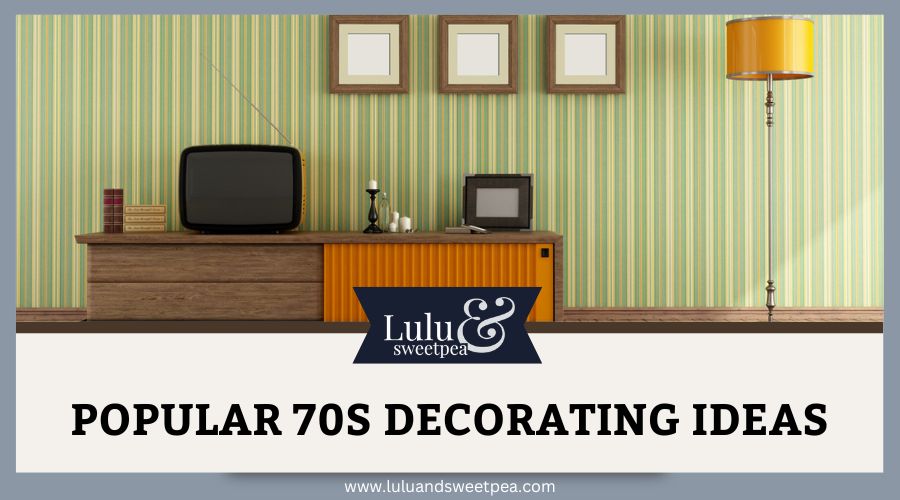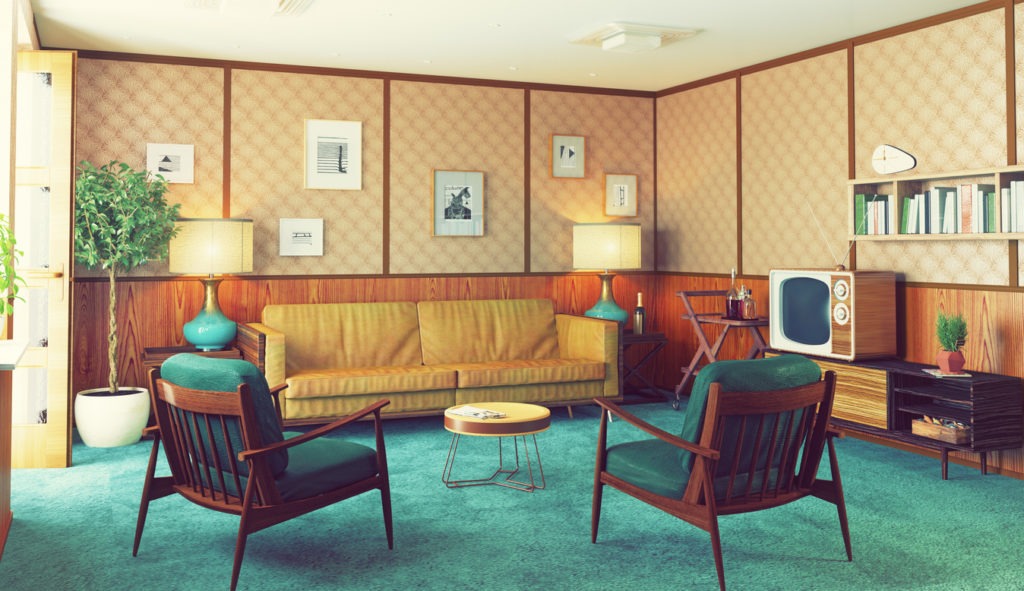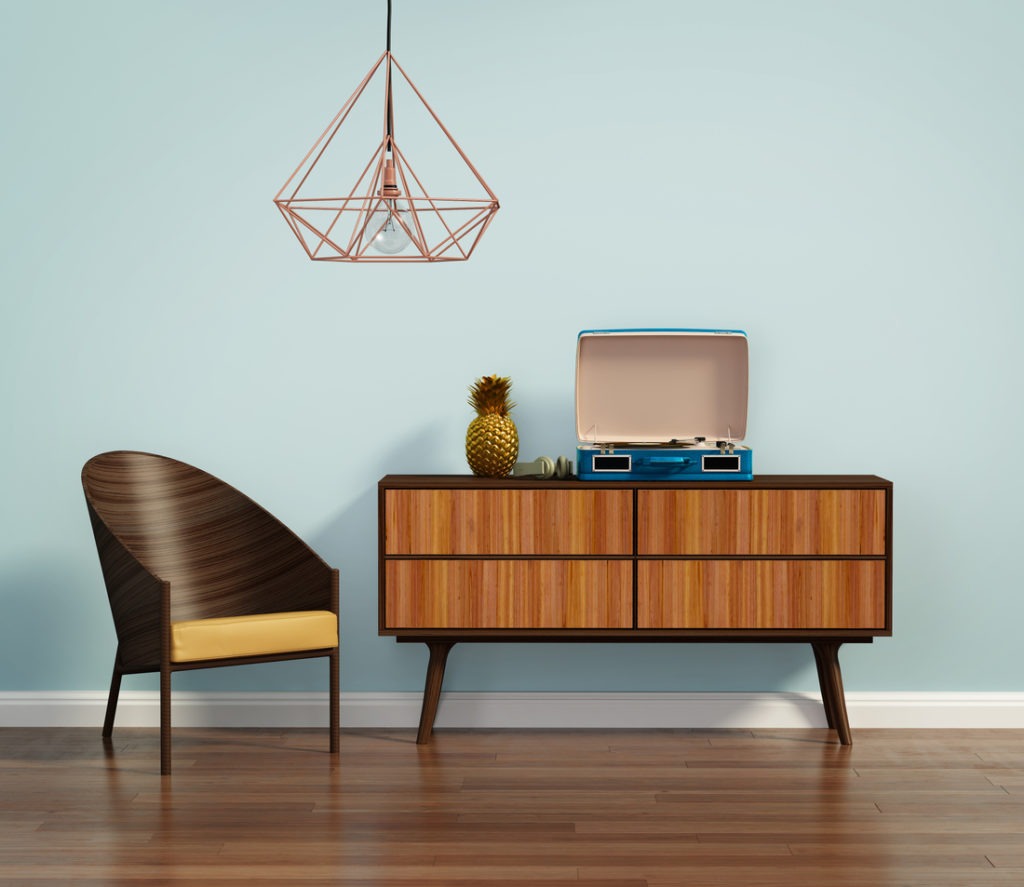The 1970s fashion trend started making a slow comeback to the runways and the fashion industry in 2021. That renaissance of 1970s interior design began to appear in 2022 and is still going strong now. The fashion from this era has an unmistakable appeal and a lot to offer modern living. Though the greatest of 1970s fashion is making a comeback, don’t worry—some of its most iconic flaws are not.
Here are some interior design trends from the 1970s that will enable you to incorporate the greatest elements of this retro style into your home while still embracing the 70s aesthetic.
7 Ideas to Use Stylish 1970s Interior Design in your Home
If plastic-covered furniture, avocado-green kitchens, and all-over shag carpet come to your mind when you hear the phrase “70s interior design,” think again. Yes, 70s interior design committed some severe fashion crimes, but it also had some very amazing elements. Here are seven methods for incorporating fashionable design concepts from the decade.
1. Natural materials
In the 1970s, bringing nature indoors was in fashion. Natural materials may be easily incorporated into your house through accents, furniture, and textiles, giving any room a design that is influenced by the 1970s. Here are a some of the many possibilities:
- Cane, bamboo, wicker, and rattan furniture
- Boho-style macrame wall hangings
- Macrame hanging planters for houseplants
- Thick, soft shag rugs (made from modern, easy-clean materials)
- Wood paneling
- Chunky ceramic vases
- Terrazzo floors and countertops
Note: Terrazzo is a building material and finish made of bits of marble, granite, glass, shell, and other materials that are mixed with cement or epoxy. It was a common choice for flooring in traditional 1970s living rooms, but nowadays you can find it on walls, tiles, and even counters.
2. Warm and vibrant colors
Warm and lively hues were used throughout the house in some great color schemes from the 1970s. There would be a combination of muted hues like avocado green, jewel-toned crimson, and sapphire blue with vivid hues like burnt orange, harvest gold, mustard yellow, chocolate brown, and tan. Even though these color schemes are a little too intense for today’s homes, they offered houses a striking appearance.
An updated method of incorporating warm, energizing hues can be found in modern design. You may give your area the charm of a 1970s house while maintaining a contemporary look by using soft tones and vibrant colors. For instance, to create a five-color palette, you might begin with a base of soft, muted earth tones and then add a few lively accent colors:
- Floral white
- Timberwolf grey
- Tan
- Terra cotta
- Cerulean frost
The majority of interior designers advise against utilizing too many vivid, strong colors from 1970s houses since it may look disorganized rather than put together.
3. Fun prints
Eye-catching prints and patterns are hallmarks of 1970s interior design and can be seen everywhere from accent pillows to wallpaper to upholstery and wall art. Consider psychedelic patterns, wacky geometric shapes, and jungle prints. What’s popular in contemporary design right now includes these striking, fun prints.
Consider purchasing a couple floor cushions with vibrant patterns for your living room to inject some vitality into the area without going overboard. Another option is to use a dramatic wallpaper pattern for an accent wall, such as big palm leaves or funky florals.
4. Textured fabrics
Your home can feel more like the 1970s with the addition of corduroy upholstery, chunky-weave throw blankets, boucle furniture, and other textured fabrics. It’s simple to incorporate textured textiles into your decor with throw pillows, sofas, accent chairs, throw blankets, and even window coverings.
For a low-to-the-ground hangout reminiscent of sunken living rooms from the 1970s, you could, for instance, surround a retro-style coffee table with corduroy floor pillows. Try textured, jute, or carved area rugs for a retro aesthetic without the excessively lengthy pile if you don’t like shag carpets.
5. Retro lighting fixtures
It’s simple to bring a hint of the 1970s to your home without going overboard by installing a few retro lighting fixtures. Try glass pendant lights in the kitchen or dining area or domed mushroom lamp shades in the living room, for instance. Lampshades made of rattan, cane, and wicker also pay reference to the bohemian aspects and organic materials popular in 1970s interior design.
6. Hanging chairs
In the 1970s, when it was all about embracing your inner creativity and sense of fun, hanging chairs were very popular. It’s one of my favorite aspects of 1970s home design because it challenges you to think creatively. A hanging macrame chair in the living room or a rattan egg chair in the bedroom are two ways to incorporate this cool hippy aspect into your home.
Try a swivel chair if hanging chairs are too much. Swivel chairs allow you to indulge your inner child while capturing the casual feel of hanging seats.
7. Maximalist accessories
Accessory maximalism complements 70s-inspired design effectively. Consider a folding screen with a large print if you wish to divide a room or simply add some visual appeal. A geometric side table, large vases, vibrant pottery, or a maximalism print can all be used as highlight pieces in your space.
The Top 5 Most Popular Home Decorations in the 70s
The next step is to begin arranging your design once you have determined which 70s home décor style is best for you. This can be accomplished by drawing a living room. A drawing of your living room that includes every piece of furniture and decoration you intend to use in the room is known as a living room drawing. This is a terrific place to start when planning your 70s home decor because it will enable you to see the room and make plans accordingly.
The following are some of the most popular 1970s home decor trends:
70s Modern Interior Design
The goal of 70s modern interior design is to create a livable place that is beautiful, useful, and pleasant. It combines classic and modern design cues while putting a focus on simplicity and functionality.
Natural materials, simple lines, and neutral hues are used in 70s modern interior design. To create a sense of balance and harmony, this design aesthetic frequently uses materials like glass, stone, and wood. When choosing furniture, consider functionality and comfort first.
Although minimalism is sometimes associated with 70s modern design, it may also be vibrant and varied. With this design, you may customize your home to showcase your individual tastes and personality.
There are a few considerations you should make if you want to create an interior design inspired by the 1970s:
- Focus on simplicity and functionality.
- Use natural materials wherever possible.
- Don’t be scared to experiment with pattern and color.
You may design a chic, cozy living area that precisely captures your taste by keeping these suggestions in mind.
Bohemian 70s Interior Design
Breaking the rules and being original were the main themes here. Bold colors and clashing patterns were everywhere. Mismatched and frequently homemade furniture was used. People then used their homes’ furnishings to show off their unique personalities.
You’ll need a few essential components if you want to give your home a little bohemian flair. Consider colors first. Interiors with a bohemian theme frequently featured strong, vibrant hues. Also significant were patterns. To create an intriguing and distinctive aesthetic, combine and match various patterns. Mismatched and eccentric furniture is ideal. Seek out items with a handmade or vintage feel. Also, don’t forget the plants! Any bohemian place must have plants.
Futuristic 70s Interior Design
The goal of futuristic 1970s interior design was to create a contemporary, streamlined appearance that was symbolic of the future. This fashion was characterized by sharp edges, geometric shapes, and frequently bright colors and patterns. Furniture designs were frequently simple, and acrylic and polyvinyl chloride (PVC) were frequently used as material options.
The use of mirrors was one of the most recognizable features of futuristic interior design from the 1970s. Mirrors were employed to give rooms the appearance of more space and to reflect light, which appeared to make the spaces brighter and more open. Geometric patterns, which were frequently employed on floors or walls, were another widely used design element.
It wasn’t only about how things looked in futuristic interior design from the 1970s. A useful and inviting living environment was another goal. In other words, storage options were frequently built into the design, and furniture was frequently positioned advantageously.
Psychedelic 70s Interior Design
This was distinguished by the use of vivid, striking colors and patterns. Floor cushions, shag rugs, and walls decorated with tapestries and posters were typical decor items. This style was frequently combined with era fashions like free love and tie-dye.
In the late 1960s and early 1970s, psychedelic interior design reached its zenith in terms of appeal. It was frequently combined with other popular styles at the time, like free love and tie-dye. Bright, striking colors and patterns served as the defining elements of this style. Floor cushions, shag rugs, and walls decorated with tapestries and posters were typical decor items.
Although it isn’t as popular as it once was, the psychedelic interior design style nevertheless has an impact on contemporary design trends. The vibrant colors and patterns that were once prevalent in this style are again returning in contemporary design. Consider including some of these components in your decor if you want to give your home a little retro flair.
1970’s Mediterranean Style Furniture
Furniture trends changed during the 1970s, which was a decade of change in general. Mediterranean-style furniture was among the most widely used designs during this decade. Bold hues, detailed patterns, and organic materials define this style of furniture.
Here are some suggestions on how to incorporate elements of the Mediterranean into your house:
Start by including vibrant colors in your room. Colors like red, orange, and yellow are frequently used in Mediterranean-style furniture. In your home, these striking hues may create a statement.
Find furniture with elaborate patterns next. This could take the form of intricate metalwork, inlaid wood, or carvings. The distinctive features of Mediterranean-style furniture are these elaborate embellishments.
Finally, whenever possible, use natural materials. In this furniture style, wicker, rattan, and wood are frequently used materials. They contribute to giving your home an organic and earthy atmosphere.
Conclusion
There were significant themes in design during the 1970s, and many aspects of that era’s fashion may still be seen now. It can be fun to mix in a feel of retro design into a more modern home.


